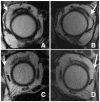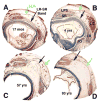"Heavy Eye" syndrome in the absence of high myopia: A connective tissue degeneration in elderly strabismic patients
- PMID: 18930668
- PMCID: PMC2728014
- DOI: 10.1016/j.jaapos.2008.07.008
"Heavy Eye" syndrome in the absence of high myopia: A connective tissue degeneration in elderly strabismic patients
Abstract
Purpose: In axial high myopes with "heavy eye" syndrome, orbital MRI can be use to demonstrate degeneration of the lateral rectus-superior rectus (LR-SR) band, with the result that the lateral rectus muscle slips inferiorly and causes esotropia and hypotropia. We investigated whether this degeneration might also cause strabismus in nonmyopic elderly patients.
Methods: Three elderly patients with strabismus, 3 strabismic high myopes, and 12 orthotropic elderly subjects underwent ophthalmic examinations and orbital MRI. The lateral rectus muscle position was determined relative to globe center from quasicoronal images and correlated with LR-SR band structure. MRI scans were compared with histology of 4 cadaveric orbits ranging in age from 17 months to 93 years.
Results: Two strabismic patients exhibited hypotropia; one exhibited esotropia. Mean axial length was 24.1 +/- 0.8 mm (mean +/- SD), compared with 31.6 +/- 1.4 mm for myopes. The lateral rectus muscle position of elderly strabismic subjects averaged 4.6 +/- 1.7 mm inferior to globe center, which was significantly lower than that of orthotropic elderly subjects (2.1 +/- 1.9 mm; p = 0.01) and similar to that of high myopes (5.1 +/- 3.2 mm). On MRI scanning, 100% of strabismic elderly orbits, 67% of strabismic myopic orbits, and 12.5% of control elderly orbits showed LR-SR band thinning, discontinuity, or displacement. LR-SR band degeneration was present histologically only in older cadavers.
Conclusions: Age-related LR-SR band degeneration permits the lateral rectus muscle to slip inferiorly in elderly nonmyopes, a mechanism of strabismus similar to myopic "heavy eye" syndrome. Imaging may assist in diagnosing this mechanical cause of age-related strabismus.
Figures







References
-
- Demer JL. Pivotal role of orbital connective tissues in binocular alignment and strabismus: the Friedenwald lecture. Invest Ophthalmol Vis Sci. 2004;45:729–38. - PubMed
-
- Hakim OM, El-Hag YG, Maher H. Persistence of eye movement following disinsertion of extraocular muscle. J AAPOS. 2008 in press. - PubMed
-
- Demer JL. More respect for connective tissues. J AAPOS. 2008 in press. - PubMed
Publication types
MeSH terms
Grants and funding
LinkOut - more resources
Full Text Sources
Molecular Biology Databases
Research Materials

